The Best Women’s Shells of 2023
Backpacker and Yahoo may earn affiliate commissions on some items promoted through links in the article below. This article originally appeared on Backpacker
Every year, technical shells get lighter, more breathable, and more tricked-out with clever features. This year's bunch represent a banner year in all departments: Designers have come up with stellar options in pretty much every corner of the category, whether you want a superlight, waterproof shell or a fully featured, alpine-ready shield. These ten women's technical shells impressed testers enough to rise to the top of the pile. (Looking for the best men’s shells of the year? We’ve got those too.)
The Winners at a Glance: Hardshells
Best Backup Rain Shell: Salewa Pedroc 2.5L PTX Light Jacket
Best Lightweight Backpacking Shell: Outdoor Vitals Tushar Rain Jacket
Best All-Arounder: Norrona Senja Gore-Tex Active Jacket
Most Comfortable: Columbia Mazama Trail Rain Shell
Most Stylish: Cotopaxi Cielo Rain Trench
Most Bombproof: Maloja TolpeiM
The Winners at a Glance: Softshells
Editor's Choice: Crazy Jacket Fly
Best For Trail Running: Montane Featherlite
Most Luxurious Softshell: Mountain Equipment Aerotherm
Best Lined Softshell: Patagonia R1 Cross Strata Hoody
How We Test
Number of Testers: 36
Number of Jackets Tested: 40
Number of Miles Hiked, Biked, and Run: 1,117
Highest Elevation Achieved While Testing: 14,158 feet
Most Consecutive Days of Precipitation: 10 days straight in Anchorage, Alaska
Fastest Wind Weathered: 40 mph in Ram Valley, Alaska
To give this season's crop of 40 new hardshells and softshells a workout, we tapped 36 backpackers, trail runners, mountain bikers, hunters, and mountain guides across North and South America. These women spent at least six weeks putting their shells through the paces, from cycling in Jackson, Wyoming to trail running in Vermont's Green Mountains to building a cabin in continuous rain in Sitka, Alaska. Testers evaluated key criteria like weatherproofness, breathability, durability, fit, and features, then reported back their hard-won performance details.
Meet Our Lead Testers
Elisabeth Kwak-Hefferan
Missoula, Montana-based Elisabeth Kwak-Hefferan is the women's shells category manager for Outside. She's been testing and reviewing technical jackets for 11 years, a gig that has taken her from Turkey to Ireland to Colombia and many points between.
Becca Stubbs
Becca Stubbs has been one of her tried-and-true testers almost as long, and Stubbs's recent move to rainy Sitka, Alaska bodes well for her gear reviewing future.
Annette McGivney
Southwest Colorado-based Annette McGivney has decades of gear testing experience and no fear of hiking during monsoon season.
The Reviews: The Best Women's Hardshells of 2023
Best Backup Rain Shell: Salewa Pedroc 2.5L PTX Light Jacket ($230)
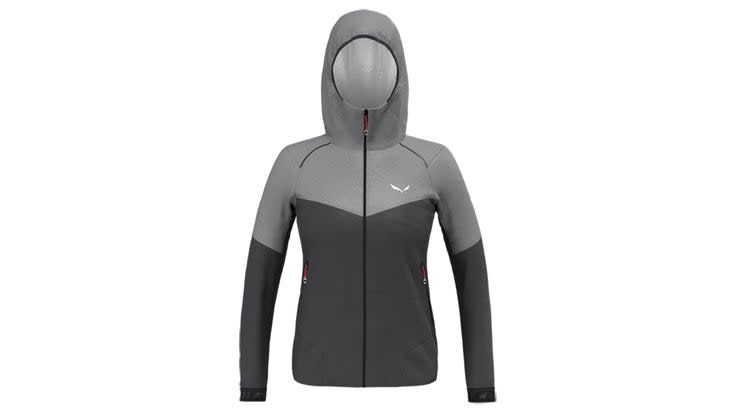
Weight: 5.3 oz. (w’s M)
Sizes: XS-XXL
Pros: Superlight and packable, yet breathable
Cons: Small hood, especially with hair in a ponytail; tighter-fitting chest means busty women might need to size up
This shell's wispy weight was the first thing to draw our attention. But when our Pacific Northwest tester Ciera Shaver reported off-the-charts breathability, we did a double-take. Many shells in the ultralight, just-in-case category can get swampy, but whether she was hiking in humid, 50-degree weather in Washington's San Juan Islands or bike commuting on misty Seattle mornings, "This shell kept me dry, but enabled me to still exercise without getting overheated," said Shaver. The proprietary 2.5-layer fabric amply fended off precipitation, elastic cuffs kept out drips but were stretchy enough to slide up easily, and the adjustable hem was simple to cinch even while on a bike. While it packs down to tennis ball size, you still get two hand pockets and a full zipper. A few dings: The small, elastic-lined hood doesn't reach to the hairline when wearing a ponytail, and though it zips up to just under the nose, doing so makes the hood too tight to wear. The streamlined cut accommodates a light midlayer, but a tighter fit around the shoulders and chest combined with the 12-denier nylon face fabric "made me worried I'd tear it while biking, though it never did," Shaver said.
Bottom Line: The Salewa Pedroc is a great pick for active pursuits like trail running, hiking, and cycling. Its weight and packability are ideal for precipitation insurance while backpacking, but it's not durable enough for extended or rugged wear.
Best Lightweight Backpacking Shell: Outdoor Vitals Tushar Rain Jacket ($230)
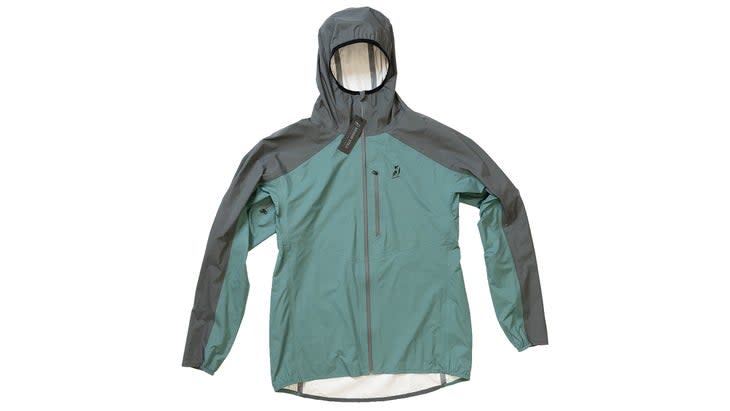
Weight: 7.4 oz. (unisex large)
Sizes: S-XXL
Pros: Lightweight and protective, with body-mapped fabrics to enhance durability and breathability in key zones
Cons: Unisex fit means smaller bodies are out of luck; tight wrists and small hood
If you like your shells light and diminutive--this one packs down to the size of a small cantaloupe--yet able to handle backpacking in most weather, the Tushar is a worthy contender. The body-mapped construction pairs a more durable, hydrophobic version of Toray's Torain 3D membrane on the back and shoulders to prevent pack strap abrasion, with a more breathable, hydrophilic version of the same membrane on the chest and armpits. The result kept sweat manageable when temps were in the 60s and below (breathability suffers in warmer weather, though pit zips help), while also protecting our tester during a downpour in Colorado's Canyons of the Ancients National Monument. "When it was raining hard, I appreciated the long sleeves that covered my hands and the long drape that covered my butt," said tester Annette McGivney, "though I wished for some type of visor on the hood to shield my face." The supple, 20-denier nylon face fabric is quiet, not rustly, a roomy cut allows for layering, and you get one chest pocket big enough for a smartphone. But the elastic-lined hood "barely fits over a ball cap" and elastic cuffs "offer no wiggle room, so I couldn't pull up the sleeve to look at my watch," McGivney reported. Fit note: Unisex sizing means women should size down (get a medium if you normally wear women's large), and there are no options for women's small or extra-small.
Bottom Line: Weight-conscious hikers and backpackers will like the Outdoor Vitals Tushar for mild to moderate weather, but its small hood and moderate breathability aren't ideal for extended rainy days.
Best All-Arounder: Norrona Senja Gore-Tex Active Jacket ($549)
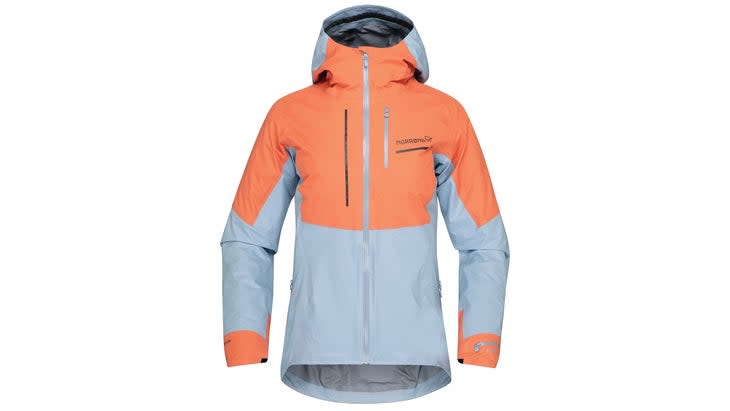
Weight: 9.7 oz. (w's L)
Sizes: XS-L
Pros: Fully featured yet lightweight; highly protective; very breathable
Cons: Pricey; some awkward features
When you don't want to compromise on weather protection, breathability, or weight, the Senja lets you have it all. Its three-layer material with a Gore-Tex Active membrane (Gore's lightest option) passed the "shovel 4,000 pounds of dirt in the heavy rain" trial for tester Angela Tomczik. "After hours of rain, my clothes were perfectly dry." It performed just as well on a wet, 50-degree hike to Colorado's 12,979-foot Mt. Toll, keeping sweat down with the help of pit zips and extra vents: one on the back (with mesh) and two zippered side vents. Features are a mixed bag: Some, like a rump-covering hem and helmet-compatible hood with a sturdy brim, drew cheers. But the small wrist pocket and "butt pocket that allows you to sit on your phone" felt awkward, and an internal waist strap (meant to make stowing the shell in its own back pocket convenient) poked uncomfortably under a hipbelt. The streamlined cut fit a couple of thinner layers, and the 20-denier nylon face proved durable over several months of testing. Of course, there is one compromise: It costs as much as a cross-country flight.
Bottom Line: The Norrona Senja is a great wet-weather shell for those who want features without too much weight.
Most Comfortable: Columbia Mazama Trail Rain Shell ($230)
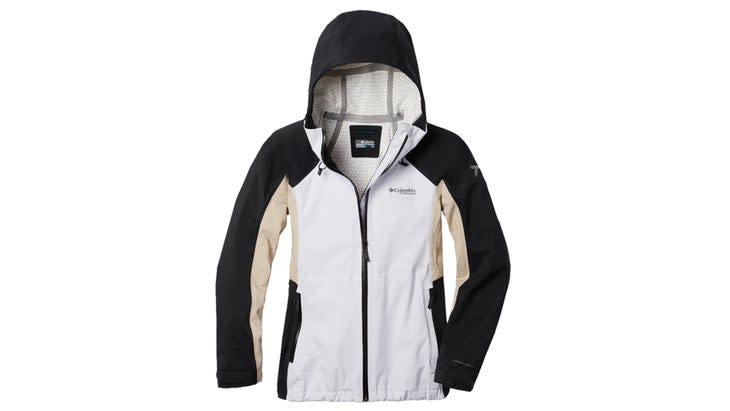
Weight: 14.1 oz. (w's S)
Sizes: XS-XXL
Pros: Excellent wicking and next-to-skin feel
Cons: Bulky
Kiss that muggy feeling goodbye in this uber-comfortable shell. Not only does the honeycomb lining, made from brushed tricot polyester, feel super-cozy, it also works overtime to banish sweat. "When bushwhacking through thick, wet brush over my head in the Quinault Rainforest, I kept the hood up and pit zips closed," reported tester Kristen Phillips, a field biologist on Washington's Olympic Peninsula. "I didn't feel sweaty at all despite the humid, low-70s temperature." The raised lining wicked moisture and kept the shell off of her skin. "Even in a sleeveless baselayer, I was very dry," said Phillips. The proprietary 2.5-layer fabric works from the outside in too, of course--it sheltered her in an hours-long rainforest deluge that completely soaked her softshell pants. The 40-denier nylon face shrugged off scrambles through blackberry and devil's club, while the two-way stretchy material provided full mobility. The streamlined cut works best with a thin layer or two underneath, and the longer-cut hem and sleeves are better for taller, long-limbed hikers. You also get a standard set of features: adjustable hood and cuffs, two pockets (ding: the hand pockets sit under a hipbelt), and pit zips. Weight and bulk sit in the middle of the pack.
Bottom Line: Hot-natured hikers and humid-weather explorers, the Columbia Mazama is for you.
Most Stylish: Cotopaxi Cielo Rain Trench ($200)

Weight: 14 oz. (w's M)
Sizes: XXS-XXL
Pros: Long cut for extra protection; stretchy; nice price
Cons: Bulky; not very breathable
Maybe your waterproof gear gets the most use when you're walking to the subway. Does that mean you need to buy a second jacket for drippy dayhikes? Not with this versatile, trench-cut number, which has the style for everyday use plus the chops for leaving the pavement. The stretchy 2.5-layer fabric (100-percent recycled polyester face) stood up to two days of steady rain and 20-mph winds in Colorado's Collegiate Peaks, and the long cut adds warmth and protection without impeding mobility. The fit is spacious: "While backpacking in the Buffalo Creek Wilderness, I comfortably wore the coat with just a t-shirt under it during the day, then added a fleece, vest, and puffy," said tester Katy Welter. "I was still able to maneuver to build a fire and retrieve water from a creek." You get a cinchable hood, waist, and cuffs, plus two huge hand pockets and a freestanding collar for extra wind protection. Tradeoff: Testers steamed up hiking even in 45-degree, windy weather, and there are no pit zips.
Bottom Line: A casual shell that can stretch into wet-weather hikes, the Cotopaxi Cielo isn't breathable or packable enough for more than that.
Most Bombproof: Maloja TolpeiM ($599)

Weight: 15.6 oz. (w's M)
Sizes: XS-XL
Pros: Burly; breathable; fully featured; four-season
Cons: Heavier; spendy
When your objectives include the windiest, snowiest, highest-elevation destinations, reach for the burliest shell in our test. "I got stuck in Puerto Montt, Chile, for a week," said tester and guide Kelly McNeil. "It was raining like crazy with tons of wind, but I was the only one who stayed dry day after day." Thank the proprietary three-layer fabric, plus storm-ready features like a two-way-adjustable hood (which fits over a helmet), super-high collar, and adjustable cuffs. And though it's light and packable enough for summer backpacking--it smushes to Nalgene size-- its 50-percent recycled polyester face also handled shouldering skis on a backcountry tour in the Argentinian Andes. But you don't sacrifice breathability: "I wore this jacket when bootpacking up couloirs and felt like it was very breathable, and I loved the pit zips," McNeil reports. More four-season features: four pockets (two chest and two hand) that fit skins or gloves and a medium cut that accommodates winter layers. But all that protection comes at a steep price.
Bottom Line: The Maloja TolpeiM is a shell for heavy-duty backpacking, mountaineering, ski touring, and alpine climbing missions.
The Reviews: The Best Women's Softshells of 2023
Editor's Choice: Crazy Jacket Fly ($220)

Weight: 1.6 oz. (w's S)
Sizes: XS-L
Pros: Class-leading weight and packability; not clammy; excellent wind protection
Cons: Few features; fragile fabric
It's become cliche to describe ultralight windshells as "barely there"--and if we're talking weight alone, that's fair enough. But in terms of breathability and comfort, you can definitely tell you're wearing the average wind jacket. That's why the Jacket Fly, from Italian brand Crazy, impressed us. Despite smushing down to baseball size and weighing less than two ballpoint pens (the lightest on the market, as far as we can tell), this shell's most laudable quality is how you don't notice it when it's on--but miss it when it's not. "It's the first windshell I've found measurably more comfortable and breathable than the ultralight rainshells in my closet," said tester Ariella Gintzler, who loved it for backpacking in breezy, low-60s conditions in New Mexico's Cibola National Forest and sunny, 50-degree runs near Santa Fe. "And the fabric is incredibly soft and stretchy." An acrylic resin anti-stick coating on the inside also prevents clamminess. None of that means you'll sacrifice wind protection: "During a blustery bike ride at 8,000 feet, my core stayed extremely warm," noted Eastern Sierra tester Lara Kaylor. "It was like the wind was just whipping around me but not actually cutting through to my skin." Features are necessarily spare in a jacket this light, but the elastic-lined hood adds welcome warmth, the elastic cuffs stay in place, and the collar is cut wide enough not to rub against your chin when fully zipped. Note: The 7-denier, "tissue paper" nylon deserves careful treatment, though we didn't rip our samples. It all adds up to one more cliche that's actually true, said Gintzler: "This thing is so light, tiny, and comfortable, there's never a reason to leave it at home."
Bottom Line: The Crazy Jacket Fly is the best, lightest windshell we've seen.
Best For Trail Running: Montane Featherlite Windproof Jacket ($109)

Weight: 3.2 oz. (W's M)
Sizes: XXS-XL
Pros: Really is featherlight; great breathability; nice price
Cons: Delicate; few features
Do you own a scale specifically for weighing gear? Then this ultralight windshell should make the cut. And even non-ounce-counters will appreciate the comfortable breeze protection this mandarin orange-sized piece provides. "I wore this trail running in Salida, Colorado," reported tester Micah Ling. "It was 43 degrees and sunny, so I assumed I'd have to take it off, but I kept it on for a 90-minute run and never felt hot," though it effectively blocked mild to moderate winds. At this weight, features are few: a full zipper, chest pocket that fits a smartphone, a hem cinch, and reflective spots on the back. It's slightly stretchy, with a trim fit and long sleeves with partially elastic cuffs that stay in place. The 20-denier nylon with a DWR treatment demands TLC, though we didn't manage to tear our sample.
Bottom Line: Ultralight trail runners and fastpackers will appreciate this streamlined windshell, especially if they're on a budget.
Most Luxurious Softshell: Mountain Equipment Aerotherm ($280)
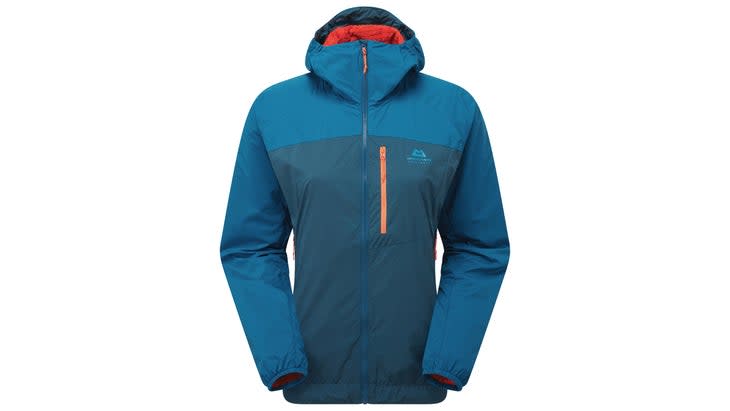
Weight: 9.5 oz. (w's M)
Sizes: XS-XL
Pros: Great weather protection and breathability; full features; comfortable lining
Cons: Expensive for a softshell
This premium softshell does all the things well. Wind protection is dialed, commented tester Miranda Mosis: "This has become my go-to for biking to work in Jackson, Wyoming. Temps are in the 40s, wind speed is 20 to 25 mph, and it does a great job of blocking the wind and keeping me warm." Details like a full-coverage, rollaway hood (it doesn't fit a helmet), long-cut sleeves, and effective water resistance to light rain add to the protection factor. As we'd expect, breathability is excellent, and a soft, micro-waffle polyester lining "really keeps it from sticking to the skin," Mosis reported. The 20-denier nylon, double-weave fabric stood up to snaggy sagebrush in the Tetons. You also get three spacious pockets, an adjustable hem, and elastic wrists, and the stretchy material fits several layers underneath. And even with those features and durability, it still packs down to honeydew melon size.
Bottom Line: The Aerotherm is the Glenfiddich of this season's softshells, with a matching price tag.
Best Lined Softshell: Patagonia R1 Cross Strata Hoody ($189)

Weight: 10.5 oz. (w's S)
Sizes: XXS-XXL
Pros: In warm weather, it's a midlayer and softshell in one
Cons: Constricting cuffs
Many jackets claim to work as both midlayers and outer layers. This one actually does. As an outer shell, the DWR-coated, 90-percent recycled polyester, 10-percent spandex double-weave fabric provides excellent wind protection. It kept Colorado tester Robin Mino toasty in 30-mph gusts on top of 14,006-foot Huron Peak. "My other body parts were chilled, but my core was warm and comfy with just a short-sleeve wool shirt underneath," she said. And it was breathable enough to wear from windy days in the mid-30s to sunny, 60-degree hikes, though we did have to unzip for venting at the upper end of the range. But the Cross Strata also served as a comfortable midlayer under a hardshell, thanks to a light-yet-cushy, fleecy zigzag pattern on the inside and ample stretchiness. That flexibility makes it a true multitasker. "If temps were above 40 degrees, I don't think you'd need anything extra, like a puffy," said Mino, who took it backpacking in Wyoming's Wind River Range. The feature set includes pack-compatible hand pockets, a chest pocket with extra pouch that's perfect for sunglasses, and an elasticized hood that fits well over ponytails and ball caps. Cut is slim, with a shorter hem (not ideal for taller people) and frustratingly tight wrist cuffs.
Bottom Line: Truly versatile enough to earn its "crosslayer" moniker, the Patagonia R1 Cross Strata will save space in your pack and your gear closet.
How to Buy Shells
Hardshell vs. Softshell
Your first decision: Do you need a fully waterproof jacket, or would you rather have a bit more breathability and a bit less weather protection? If it's the former, buy a hardshell; if the latter, a softshell is for you. Though technical hardshells are getting more breathable by the season, their waterproof membranes will still impede body heat from escaping to some degree. Another significant difference between the two is stretch. Softshells traditionally have a lot more flex to them, making them more comfortable to wear, but there are a handful of truly stretchy hardshells on the market these days as well.
What to Look for in a Hardshell
Durability
Think about what activities you'll be doing most. If you're a hardcore mountaineer, you'll need a durable shell (check the fabric's denier; the higher the number, the tougher it is) with high-quality features like a helmet-friendly hood and large pockets.
Weight
These bombproof shells are clutch in mountain weather, but they're the heaviest and among the most expensive available. If you're a dayhiker or ultralight backpacker (or just live in a dry climate), a much lighter hardshell will save space and weight in your pack.
Feature Set
Climbing? Make sure your shell fits over your helmet, has a harness-compatible hem and pockets, and enough stretch for you to move freely.
Breathability
Breathability is the major X factor in all hardshells. Different people prefer different technologies, but air-permeable membranes (like NeoShell, Outdoor Research's AscentShell, and Pertex Shield Air) and the Gore-Tex family of fabrics are all good bets. Pit zips and long side zips or vents allow you to cool down quickly, no matter the membrane.
What to Look for in a Softshell
Softies are further divided into "regular" softshells and windshells. Windshells are the lightest of the light, meant to block wind and add a touch of warmth, and ideal for trail running and dayhiking. More traditional softshells weigh a bit more and often have the same features hardshells do, such as hoods, adjustability, and pockets. They usually provide a decent amount of water resistance, but won't save you in a downpour.
For exclusive access to all of our fitness, gear, adventure, and travel stories, plus discounts on trips, events, and gear, sign up for Outside+ today.

